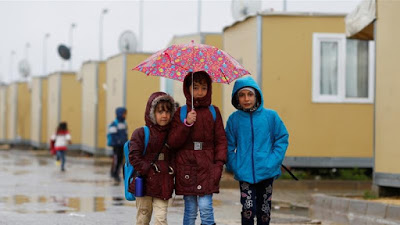When schools reopen, many children will be missing
 |
| Zama Neff 08 June 2020 |
Governments must make sure disadvantaged children do not drop out due to socioeconomic and legal barriers.
“I loved school,” said 11-year-old Radwan. “I liked to study math, and I miss going to school very much.”
Radwan could be any one of the more than 1.5 billion students whose schools closed because of the COVID-19 pandemic, but he is not. Radwan is Syrian, and fourth grade ended for him when his family fled the war to Turkey. He is among the 258 million children and youths, including half of all refugee children, who were out of school last year.
Without education, children do not gain the skills they need to fully participate in society and exercise their rights. They are more vulnerable to exploitation, including child labour, child marriage, sexual violence, trafficking, and recruitment into armed groups and forces. Education helps economies, and when children are not in school, societies lose all the benefits that education brings. These include passing on health information, which in a pandemic is critical.
School closures necessitated by the COVID-19 pandemic risk undermining the benefits reaped from marked increases in school enrollment in recent decades. While schools in only a few places have reopened, many are considering how and when to safely resume. Important new guidance for officials making those decisions has come out that addresses how to get schools running again. But children like Radwan, and his three brothers and sisters who were also already out of school, are still missing from the picture.
The reopening of schools provides a new opportunity to extend education to the children persistently excluded from schooling before the crisis. These children should feature prominently in government plans. Education can be built back better – if it is done right.
First, as schools prepare to reopen, governments will have to do intensive outreach to ensure that at-risk children return. This should include pregnant, parenting, and married girls; children sent to work as families sink deep into poverty, leaving them unable to pay school costs; children with disabilities or underlying health conditions whose families fear that they are at greater risk if they return; and children who simply fear they have fallen too far behind.
Governments and schools should compare who left school and who came back, and seek out those who fell away. Outreach should be broad, to include children who were already out when schools closed.
Second, once schools open, educators will need additional support. Many will be unable to take up where they left off but will be forced to adapt to students at an unusually wide range of levels, from those who enjoyed books, internet, and quiet places to learn to those who had no real distance learning for months.
Children with disabilities who were unable to get accessible materials or were not provided with needed accommodations may be especially disadvantaged. The need to help so many students catch up makes it plausible to incorporate those who were out for other reasons. If there are teacher shortages, countries like Lebanon and Jordan could use refugee teachers who are instead barred from running classrooms.
Third, governments should eliminate discriminatory rules that prevent children from attending. This should include policies that explicitly block refugee children for political or other reasons. Bangladesh, for example, should lift its prohibition on formal education for most Rohingya refugee children and allow humanitarian agencies to provide it. Armenia, Kazakhstan, and Serbia – to name a few – should end their discriminatory practices against children with disabilities.
Governments should also change policies that harm all students and encourage dropouts, by banning corporal punishment, mandatory pregnancy testing, and the exclusion of pregnant students and young mothers. Governments that have not done so should prohibit military use of schools. These changes can be done now, with the stroke of a pen.
International education donors, including the World Bank, Education Cannot Wait, and the Global Partnership for Education – and donor governments such as those of the United Kingdom, United States, Canada, and France and other European Union countries – should use their leverage, especially when providing new funding, to secure commitments now that countries will take these steps.
Finally, in light of profound financial pressures on the global economy from COVID-19, both host governments and education donors should not only target funding for education but also reconsider the low priority – and chronic underfunding – so long given to providing education under emergency conditions.
Many officials are parents whose new experience with their own children missing school should give them a better understanding of the importance of resuming education for all children as quickly as possible. This is a lesson from COVID-19 that should be learned for good: education should be vigorously protected, and truly be available and accessible to every child.
The views expressed in this article are the author’s own and do not necessarily reflect Al Jazeera’s editorial stance.


